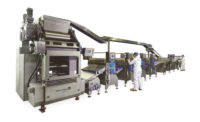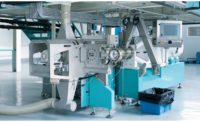Snack and bakery industry customers want belts and conveyors that are fast and easy to clean, maximize energy efficiency, offer strength and durability, require as few tools as possible, and provide flexibility to either switch out products and/or run multiple products at once, according to manufacturers of those components.
Customers of Dynamic Conveyor Corp., Norton Shores, MI, want to be able to clean their belts and conveyors more quickly for the time and money savings, says Paul Kuharevicz, sales project engineer. “Anyone in food knows that’s where you can make or lose your money. You have to do it very, very well. And they want everything to be toolless,” he says. “Our conveyors break down very quickly. What we hear is, ‘How much time can I save?’”
Cleanliness and sanitation is high on the list of requests directed toward Ashworth Bros., Inc., Winchester, VA, says Jonathan Lasecki, director of engineering. “Easy to clean, easy to maintain,” he says. Customers ask about how it will be cleaned and maintained, not only during sanitation, but for also repairs and installations.
Bryan Hobbs, North American sales and service manager, Ashworth Bros., says its customers want the flexibility to operate multiple products on the same equipment, as well.
“We understand that the food industry is moving more toward just-in-time component delivery, and we are focused on meeting this requirement, as a manufacturer,” says Lasecki.
ProMach, Cincinnati, hears about customers alternately looking for higher speeds, flexibility and changeover, and/or cleanability, says Todd Eckert, inside sales manager.
Customers of PFI Global, Algona, IA, want cleanability and flexibility, as well, says Rocky Olmstead, engineering R&D manager. End users want components with no hollow pieces and the ability to reverse product flow without stopping the motor. “We’re seeing a lot of people going ahead and making it all stainless-steel components,” he says. “We’re using a lot more motorized pulleys on our conveyors than what we probably used to.”
Hygiene, cleaning, safety and energy are among the top priorities of customers of IPCO, Sandviken, Sweden, according to Staffan Karlson, global marketing manager. “That is the big thing, the environment,” he says. “Recycle your stuff. Steel is recyclable. And a steel belt helps them to conserve energy. More and more, not only we but the industry as a whole is talking about energy savings. To heat up a bakery oven costs a lot of money.”
AMF Bakery Systems, Richmond, VA, finds that sanitary design is probably the most-significant trend in belts and conveyors, says Bobby Martin, executive products manager. “Sanitation goes with easy access for cleaning and maintenance,” he says. “It simplifies the design, with fewer parts.”
Customers of G&F Systems, Roosevelt, NY, want belts and conveyors that are faster, stronger and more durable, says Anthony Salsone, associate at G&F. “Our ‘Spiral Engage’ technology is the answer to these requests, all while meeting the needs of customers who are looking for a stainless-steel cage driven system,” he says.
New and improved
G&F’s Spiral Engage is a positive-driven spiral belt in a stainless-steel option, directly driven by the spiral cage, which offers superior product orientation and performance vis-à-vis a traditional low-tension system, Salsone says. Available in a wide array of configurations—including rods only, grid patterns and mesh overlays—this also offers cost reductions in cleaning and an increase in belt life, he says.
Ashworth Bros., Inc., most recently has added a high-density mesh option to its Omni-Grid 360 Weld product line, says Kenneth King, commercial support manager. This High Density Mesh overlay, with its patented intermediate loop design, provides a 45 percent reduction in mesh weight along with improved airflow to shorten dwell times and increase output. The new option is an alternative to Omni-Grid-style belts, which use heavier dense mesh overlays for supporting these types of products in both tunnel freezers and oven applications.
Ashworth also has released the SmartSpiral Monitoring System, a stand-alone wireless web app, Lasecki says. “They can access real-time performance data their cellphones, tablets or computers and look at all spirals across multiple plants,” he says. They can see how the belt is performing and be able to see warnings if there are any particular issues. “If there are any anomalies in bottom bearing performance, belt tension, or outfeed and cage drive operation, the system will alert the customer.” And the system tracks measurements over time, so the plant can monitor performance and do predictive rather than reactive maintenance, he adds.
Lastly, Ashworth has rolled out the SpiralFlow all plastic low-tension belt, which offers 65 percent open area for improved vertical air-flow, as well as greater strength than other belts in its class, King says. “The outer hinge design allows for increasing rod deflection, so tension is shared over multiple hinges, thus preventing concentrated tension on one hinge,” he says. “This tension-sharing design increases operating strength and belt life.”
ProMach has improved upon its Shuttleworth high-speed lane divider to provide more flexibility and thus faster changeover, Eckert says. The new and improved version also has mechanical parts mounted entirely underneath the surface, which improves cleanability, he says.
“The laner takes a single-line input, sometimes two lines in and then two lines out, to six, eight, 10 lanes,” he says. “It’s switching lanes at the same time the product is added.” This is much gentler on the products, and it allows for increased speeds because the operator doesn’t need to stop the line and shift product. “We gain time in doing that.”
PFI Global has released the PURmotion horizontal motion conveyor, which works similarly to a vibratory conveyor except that it uses “more of a linear shuffle,” Olmstead says. “We have made a unit that’s one of very few that would be allowed in a ready-to-eat facility,” he says. Everything is washdown-compliant. There aren’t any hollow parts, and everything is stainless steel. “We removed a lot of components and made everything easily cleanable.”
PFI Global also has rolled out the PURlift sandwich conveyor, which Olmstead notes doesn’t make sandwiches but has two belts that run in parallel, with a pinch belt that grabs the product and takes it up the line. PURlift is most often used for making dough, and PFI is figuring out what else it can be used for, he says. “We have an adjustable gap system, and a horizontal feed section that goes into the pickup of the unit.”
IPCO has released new wider bake oven belts. Where most range between 32 and 59 inches, these are 141 inches wide, Karlson says. “That makes it possible to produce more and with better efficiency, at a location where space is a limit,” he says.
IPCO also has gone online with an app that shows customers the energy usage of the company’s belts vis-à-vis others, which representatives bring to customer meetings and exhibitions, Karlson adds. “We are working very closely with end users and machine builders to customize their operations, when it comes to tracking, steering and so on, on their existing equipment,” he says. “We have been doing the tracking development, as well.”
AMF Bakery Systems has developed a horizontal diverter for conveyors—flat diverters that consist of a rod and pin that feeds into a hollow chain, Martin says. “There’s a plastic slat that rides in between the rods that brings the product right to left,” he says. The company has worked with Intralox to develop the new Active Integrated Motion (AIM) belt, which provides noise reduction, easier cleaning and maintenance, and improved worker safety.
Dynamic Conveyor also has partnered with Intralox to create a high-temperature belt that’s permanently attached via welding, Kuharevicz says. “That’s where the advancements in conveyance for food are,” he says. “You can talk about supports, you can talk about motors—they change and evolve, and they’re getting better and not worse. But where the magic is now, is in belting.”





